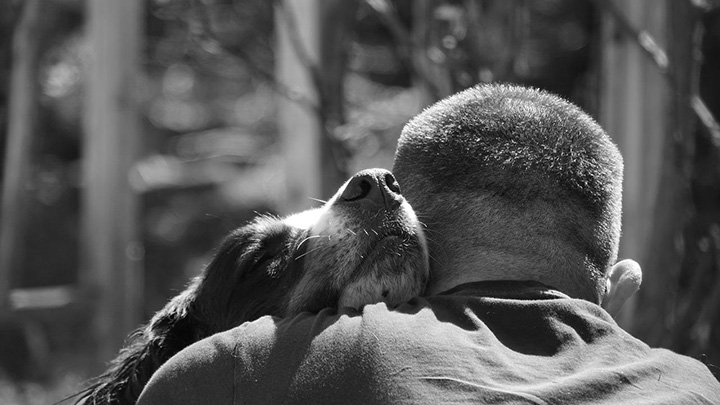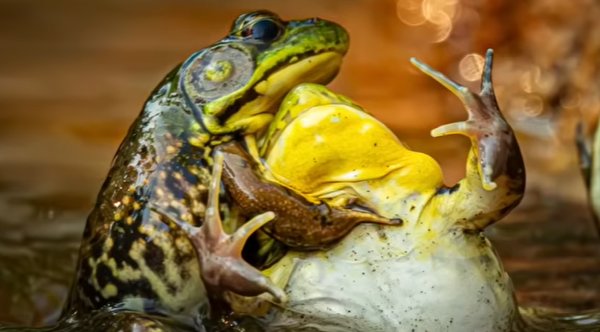Like Humans, Dogs Cry Tears Of Joy When They're Happy
August 23, 2022
In humans, tear volume increases during emotional arousal.
Japanese scientists wanted to see if the same thing happens with dogs.

Takefumi Kikusui, a professor at the Laboratory of Human-Animal Interaction and Reciprocity at Azabu University in Japan, decided to investigate dog tears after he noticed his poodle's eyes got teary as she nursed her puppies.
"To our knowledge, no previous studies have investigated the relationship between emotional arousal and tear volume in animals," the authors wrote in the study published on July 31, 2022.
The researchers found that dogs' tear volume increased significantly during a reunion with their owner, but not with a non-owner.
"We found that dogs shed tears associated with positive emotions," Kikusui, who coauthored the research that published Monday in the journal Current Biology, said in a press release.
"We also made the discovery of oxytocin as a possible mechanism underlying it," Kikusui said, referring to the hormone that in humans is sometimes called the love or maternal hormone.
With the help of 20 dogs, researchers compared the amount of tears before and after reunions with their owners and people with whom the animals were familiar.
Only the reunion with the owner increased the amount of tears.
"In the first experiment, the dogs' tear volumes were measured by STT in their normal home environment with the owner present (baseline), and within the first 5 minutes of a reunion with the owner following 5 to 7 hours of separation. A mixed model analysis revealed that tear volume significantly increased during the reunions," the authors wrote.
"Secondly, we compared tear volumes before and after reunions with owners and familiar non-owners. Following separation from the owner in the dogs' day care centers, dogs secreted larger tear volumes during reunions with their owners than with familiar non-owners, and tear volume during reunion with the owner was significantly greater than the baseline tear volume."
To understand whether oxytocin played a role in producing the tears, a solution containing the hormone was applied to the surface of 22 dog' eyes. The amount of tears significantly increased after the oxytocin was applied, compared with a control solution.
This is the first report on positive emotion stimulating tear secretion in a non-human animal.
"Unlike any other animals, dogs have evolved or have been domesticated through communication with humans and have gained high-level communication abilities with humans using eye contact," the authors said.
Click Here For The Most Popular On Sunny Skyz
 Boy With Down Syndrome Nails The Whitney Houston Challenge, And The Crowd Goes Wild
Boy With Down Syndrome Nails The Whitney Houston Challenge, And The Crowd Goes Wild
 Husband Rents Mall Store To Share His Late Wife's Beloved Christmas Display
Husband Rents Mall Store To Share His Late Wife's Beloved Christmas Display
 The ŌĆśGrandma StandŌĆÖ Is Bringing Comfort And Connection, One Conversation At A Time
The ŌĆśGrandma StandŌĆÖ Is Bringing Comfort And Connection, One Conversation At A Time
 This Priest Secretly Became A Masked Wrestler To Fund An Orphanage
This Priest Secretly Became A Masked Wrestler To Fund An Orphanage
 The Funniest Wildlife Photos Of 2025 Are Here ŌĆö And TheyŌĆÖre Hilarious
The Funniest Wildlife Photos Of 2025 Are Here ŌĆö And TheyŌĆÖre Hilarious
 This 30-Year-OldŌĆÖs Christmas Gift To His Mom Is Going Viral
This 30-Year-OldŌĆÖs Christmas Gift To His Mom Is Going Viral
 Dad Jokes With Tom Hardy And His Dad
Dad Jokes With Tom Hardy And His Dad
 After 2 Years Apart, Siblings In Foster Care Are Finally Reunited
After 2 Years Apart, Siblings In Foster Care Are Finally Reunited
 The Hug That Went Viral On Facebook
The Hug That Went Viral On Facebook
 You Have To See This 'Piggy Train' Trotting Through The Snow
You Have To See This 'Piggy Train' Trotting Through The Snow
 SheŌĆÖs Been Helping Hungry Children For Years ŌĆö This Christmas, Someone Helped Her
SheŌĆÖs Been Helping Hungry Children For Years ŌĆö This Christmas, Someone Helped Her
